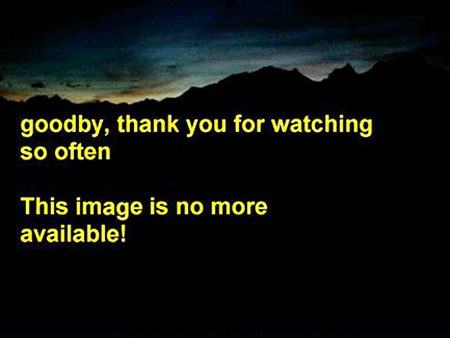Image, apparatus, programme
and information
a conversation with Kurt Caviezel
interviewed by
Wolfgang Brückle and Mark Durden
Wolfgang Brückle
is senior lecturer for photography theory and visual culture at the Luzern Academy of Art and Design, Switzerland.
Mark Durden
is Professor of Photography at University of South Wales, Cardiff, Wales.
January 2017
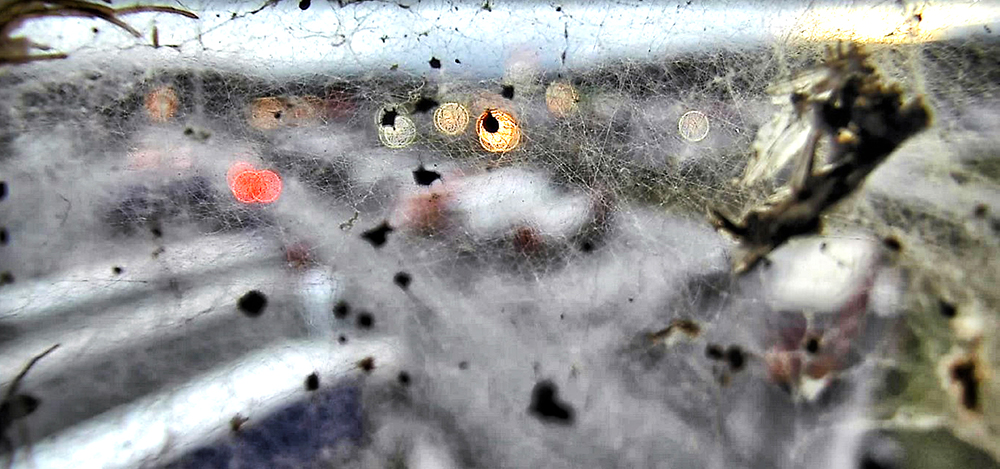
insect 328
INTRODUCTION
For fifteen years Kurt Caviezel has been amassing millions of images from his studio in Zurich by taking screenshots from the thousands of worldwide netcams – or webcams, surveillance cameras, IP cameras – that are now publicly accessible online. Since he takes his pictures from a live image stream feed, his work is distinct from appropriationist practices drawn from the internet. Every time he grabs a frame, he gets a new and original picture that would not otherwise exist.
The netcams’ surveillant recording of the world must stand for the ultimate degree zero in documentary. But by ordering and arranging pictures according to the discovery of recurring patterns and behaviour, Caviezel turns this machinic vision into poetry.
One group, collected from the same camera over many years and registering changing light and weather conditions, concentrates us on the view from on high of a bus stop, billboard and a single figure waiting. The street scene is relatively empty and each person is shown to be standing in a similar position by the road, a recurrence that creates a sense of eternal loneliness and expectancy.
Many images attend to the unexpected comedy or beauty of mistakes and aberrations in the recording equipment – the cameras that are still recording when window blinds are closed, when lenses are being cleaned, or the pictures showing all the spider webs that have been spun in front of cameras, the insects, birds and birds’ tails that have unwittingly got in front of the lens, as well as the ways in which dust, water, snow and ice have obscured and transformed views.
One series, humorously entitled ‘Self-Portrait’, includes the shadows cast by the cameras and the structures they are attached to, a succinct reminder that this is a detached and fundamentally inhuman vision.
Another series captures the handwritten phrases held in front of the camera by one individual to unkown others, turning fragments of spontaneous conversations into so many messages in a bottle.
One is hard-pressed to find anything intrusive in this collection of anonymous images made public before Caviezel’s turning them into permanent pictures. Never, it seems, has photography come closer to confirming the notorious complaint that all it does is mechanically register the world. But then maybe the question of agency has also never been trickier before. In fact, we will never stop wondering to what degree Caviezel’s imagery is reminiscent of the curiosity of the private eye or of an omniscient God-like perspective on the world.
Parts of the following interview were made in Caviezel’s studio in Zurich on 17 Nov 2016, and more questions and answers were added in a subsequent email conversation, which was translated from the German by Wolfgang Brückle.
Wolfgang Brückle and Mark Durden
INTERVIEW
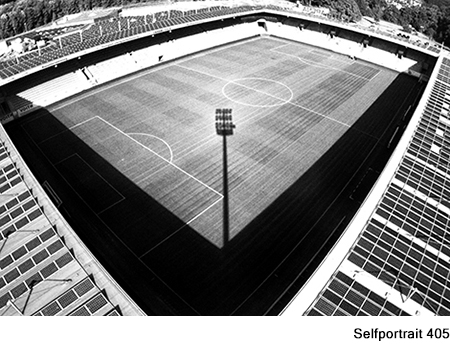
WB and MD: In the title of your 2015 book, The Encyclopedia of Kurt Caviezel, it is ambiguous as to whether Kurt Caviezel is the author of the book or its subject. Was this deliberate?
KC: Yes, indeed, the ambiguity was intended. While I considered other project titles in the beginning, with The Encyclopedia of the World, The Encyclopedia of Netcams, The Encyclopedia of Images among them, I was dissatisfied with their one-dimensionality. In what we may call a poststructuralist turn in my perspective, I wanted to point to the practice of picture-making via the web: You are visually live on location, but your body is at another place. This photographic ambivalence is new and I wanted to make it evident in the title. I am indeed both the author of the book and, to a certain extent, its subject.
WB and MD: You had proceeded differently in your previous project, Red Light from 1999. In a series of black and white photographs, you used a film-based process that was already in the process of becoming old-fashioned. You also seemed to follow a more traditional conception of the observer’s status and point of view.
You took snapshots from an apartment window, using a long lens looking down on people in cars waiting at the traffic lights, and you used the classically voyeuristic premise of the blow up to present often intimate moments and gestures. The title’s suggestion of the illicit further reiterated the transgression of the photographic act. Was there a particular curiosity that drove you, and do you feel your role was different then?
KC: The setting was different when I worked on Red Light. It did, however, share characteristics with netcam photography. I took my traditionally analogue photographs with my own camera, which was mounted on a tripod. I was constantly present and had the option to turn the lens where I desired. Thus, I was able to observe fifteen to twenty cars queuing in front of the red light. The rectangular windscreens framed quasi-pictures which reminded me of negative or film strips. These strips would pass before my camera in the rhythm of the red light, and I made my pick from the flood of images by turning some of them into photographs with my 1000 mm telephoto lens. There was less distance to the action than with netcams. Things were happening right before my front door, and so I felt culturally closer to the information I was collecting. More cultural knowledge on my side was implied. And I was in a position to choose the angle of the lens.
WB and MD: It is our impression that the sequencing of pictures is critical. It calls attention to patterns and highlights the mechanical and repetitive nature of certain human gestures: hands pointing, people yawning, pinching the skin on their arm etc. Your grouping and ordering seems to create a comedy out of human behaviour by showing how routine and mechanical our spontaneous gestures are. Could you comment about this editing process and its effect?
KC: I was interested in the small gestures during waiting time in these semi-public capsules. What do people do when they don't have anything specific to do in their un-private living room on wheels? Are they aware that they are not alone? Where are the drivers' limits of privacy? What is probably the result of my enquiry is a little anthology of waiting, classified in a typology of gestures.
However, gestures can change their meaning when photography isolates them from their original context. When you contemplate twenty photographs of yawning people, this gesture will start to change its essence, and there is a moment where you start to wonder if they actually are yawning. They may all be screaming or, like in a big chorus, collectively engaging in a song. Such effects undermine the individual gestures and unveil a collective sub consciousness. This can be very comic although there is also a kind of lucid melancholia lurking behind it.
WB and MD: Although there is seriality and order in these pictures, their aesthetic and your focus on micro-actions and ephemeral phenomena of daily life evoke a continuity with street photography. At the same time, there is an obvious tension between the paradigm of street photography and the repetition of gestures that reminds us of the machine driving this mode of picturing, which you then more fully embrace when you abandon your camera and turn to netcams.
KC: Precisely. Generally speaking, I like to take positions, also in a literal sense, and see latent images floating by in a pleasant rhythm.
This rhythmic aspect is an important aspect of this project when taking photographs and in the process of selecting and in their presentation on the pages of a book. Some of the series ask a for a 'staccato' reading, others for 'glissando'.
The same is true for the gestures, some will be performed fast and others not. Tempo was an important category in this project.
By the way, this project also led me to discover netcams. After Red Light, I wanted to explore the same setting in different cultures; I would have loved to see how people in Peking, Tunis or Rio de Janeiro responded to the same standard situation, if there would be any differences to be seen.
Yet this project would have required a lot of time and money, and the latter I lacked. Then an IT colleague pointed me to so-called traffic cams which, in the US, were used to observe crossroads via the web.
While I soon realised that these cameras weren't useful for me, I became ever more fascinated by photographing the world via the internet. Actually, I felt I was coming across the foundational principles of my Red Light again: the fixed point of view, the flood of images, the rhythm, the tempi, the mechanical and so on. It was just all reappearing on a higher level, and the range of possibilities of my photographic approach seemed to explode.
WB and MD: While it is evident that there are conceptual continuities between Red Light and The Encyclopedia of Kurt Caviezel, it probably makes sense to explore the differences a little further. In the latter project, you turn existing visual material into new pictures through screenshots from live publically accessible netcam image feeds. Can you describe in more detail how you make your photographs and access these netcams?
KC: On my daily virtual strolls, I always open several cameras at once in my browser tabs. Netcams feed live images at different intervals into the world-wide web, ranging from very short intervals to just one-picture-a-day supplies.
A small portion of them shows the world as a video stream. In these cases, I take screen shots in the full screen mode.
Yet in most instances, I access the camera via a bookmark, and when the image appears in the browser, I download the image file onto my server; then I refresh the browser and the next live image appears. Overwritten by a new image, the previous image now only exists in my archive. All this is handicraft work without automatization.
As a matter of fact, this way of proceeding is the most effective in spite of the number of sources available. Presently, I have about 40.000 links to live cams bookmarked on my computer.
There is a continuous growth, while at the same time I have to eliminate discontinued netcams from my link database. I find new links via queries in search engines on the web. I get direct access to the cameras on the hosts’ websites or sometimes to full lists of cameras in a certain city, in an area, or in a country.
Special queries lead me to unprotected IP cameras. I should like to underline that all the cameras in my lists are publicly accessible. I never hack netcams.
WB and MD: It is not impossible to conclude from all this that you are still acting as an old-school photographer, albeit with the help of a new apparatus. Was there really only a change of instruments when you put down your camera, or do you think that with a different optical technology, there was also a broader conceptual shift?
KC: Let’s put it this way: the internet is one huge camera for me. My screen is my viewfinder; my mouse is my button; the netcams are my lenses: lenses with a sensor that serve me somewhere far away.
The light beam, to put it in traditional photographic terms, has to go a long way from the focal point of the lens to my viewfinder, sometimes across continents. This dislocation is obviously new and has a huge impact on how the essence of my way of taking photos can be framed.
There are several paradoxes we need to become acquainted with in the first place. Netcam photography is extremely dynamic – you can be at various most far-away places at once. However, the lens stares inflexibly at the world more often than not. Netcams also bring me very close to the people I am photographing in their homes – he or she will often behave very intimately in front of their cameras. However, I am not personally involved. Here, the paradox is: the bigger the special distance to my models, the closer I get to them. And there is another paradox. Picture production via the web is part of a dynamic-disembodied system.
My spatial location and orientation become unimportant. At the same time, this system imposes itself as an extension of my body, with unexpected effects: when one of my favourite cameras is discontinued, I suffer from a phantom-limb pain.
WB and MD: Vilém Flusser said that it is the camera apparatus rather than the photographer that takes the picture. He was referring to the automatic nature of cameras and how they determine the kind of pictures we make or take. All relations to technology can be said to involve possibilities or constraints and limitations in terms of picture making. You seem to be very much involved with this problem. Do projects like yours confirm Flusser’s view or add another aspect to what his theory can tell us about photography?
KC: Image, apparatus, programme, and information are key terms in Flusser’s philosophy of photography… I locate my own work in the same field. However, the roles of the photographerand of the apparatus have changed. Actually, the netcam photographer does not press thebutto n. He downloads the image file, which the lens and sensor previously automatically generated, onto his or her computer. The cadence of shots, the shutter speed and aperture and other technical parameters are ruled by software, and so is the distribution in the web.
The cropping is chosen by a human being, but he is not – with the exception of a few netcamscont rolled via the web – the photographer. He is a technician who installs the camera on a facade, a roof or a street lamp. He will frame ‘beautiful’ scenery or choose an extreme angle with the particular function of this or that camera in mind. It would be exaggerated to identify this technician with a photographer; after all, he acts in service of the hardware. He decides upon the framing of the scene, a constitutional photographic act in traditional photography. However, he has nothing to do with the picture. He does not playfully interact with the camera; he simply does the preparatory work, as if mounting it on a tripod. The netcam is a photographic system that generates images and also deletes them or, to put it more dramatically, it gives birth to images in the process of annihilating others. Or, to use again another expression: it works on the same images over years or decades by constantly proposing new variations and rejecting the previous ones. Referring to Flusser, we may say: the netcam plays with the images. The netcam photographer interferes with this process by saving variations from oblivion.
As opposed to Flusser’s view on traditional photography, however, the netcam photographer does not play with the netcam to improve his or her images. Rather, it is in the endlessly repetitious action of the netcam that we can find play. If we decide to identify the internet as an apparatus, however, the individual netcam – that is, a lens with a sensor – is only a small portion of the camera.
Millions of lenses link up to a camera that is permanently transformed, with new lenses joining and others disappearing.
As a photographer, I realise I confront an apparatus totally different from how it was described by Flusser. My apparatus is omnipresent, it is everywhere. My
connection with it is different. The apparatus is not tangible, and it is forever changing its form.
It is inside and outside; it can be solid or fluid or gaseous; it can be a swarm or a cluster and a black box or a white cube or a handful of pixels.
WB and MD: Your last remarks remind us of the many pictures which, forming distinct sets of images or rubric in The Encyclopedia of Kurt Caviezel, depict the technology itself and also its functional failings. It seems obvious that you are fascinated with flaws in the mechanical system, and this creates a particular aesthetic from out of glitches, mistakes, errors.
There is also a range of pictures about how the physical camera has been used by insects and birds for their own purposes, and yet the camera, or simply the lens and sensor to take up your description of the larger apparatus, continues to register. The images resulting from this encounter of technology and unconscious models resemble this penumbral nineteenth-century photograph with a moth whose fleeting presence was inscribed into a plate that was supposed to document the Pyramids: one brief life contrasting allegorically, if accidentally, with the enduring monuments.
It seems to us that both your images of the apparatus, and of similarly accidental encounters, were included in your book to reflect the medium. They probably also reflect your authorial position?
KC: Yes, they do. On the one hand, I want to use the apparatus in order to study the world outside. On the other hand, I interrogate the conditions under which photos are created. Picture, apparatus, programme, information are similarly important phenomena for my research activities.
The series of insects and birds in my encyclopedia investigate the properties of the apparatus as a thing, as hardware, and the impact these properties have on the image. More often than not, the lenses and sensor are mounted in their box high up onto a wall that is only accessible by means of cranes or ladders for men. They are exposed to all kinds of weather and wildlife. Profiting from the situation, insects and birds turn the boxes into their habitat. Spiders spin their nets in front of the lens; flies and mosquitos crawl about the lens; bird rest on the boxes with their tail feathers hanging into the images. Needless to say, it was never the camera operators’ intention to photograph these animals.
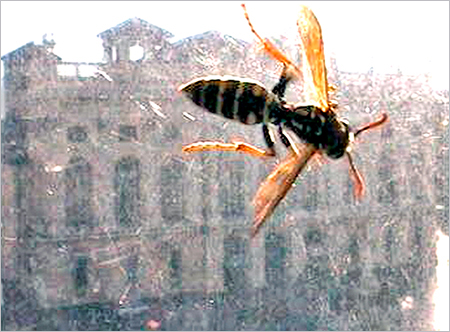 insect 108
insect 108
The animals and apparatus, however, could not care less about the agenda of the operators. They create images and aesthetics that a photographer with his or her own camera cannot produce unless they take pictures with a camera inhabited by moths, and of course your example of the nineteenth-century photograph proves that this was not entirely impossible. In our world, however, there is more to the apparatus than just an inside of the box.
WB and MD: Can you say more about what you consider the ‘world outside’? It strikes us that your practice is very ambivalent in terms of how we normally try to make sense of the inside and outside worlds, and also in terms of where the inside of the apparatus is to be located.
KC: This term is indeed problematic. As a matter of fact, the apparatus is all around us. It has come to envelope us. We move within the apparatus, as it were, and it is no longer convincing to make a distinction between inside and outside. Just like in political discussions about the realm of the private and the public: the distinction becomes obsolete when inside and outside visibly overlap in one and the same space. And web photography has the power to make everything visible.
Nowadays political discussions about these problems always ought to include a critique of the apparatus, and I would like people to think of my work in this broader context.
Apart from showing shadows cast by the camera and accidental encounters with the animal world, I made a series entitled ‘Error’ where I collected images affected by failures of electronic data transmissions. These failures assume an interesting life on the surface of the image. One part of the picture is still a representation of the world ‘outside’; the other part is a representation of the apparatus or the programme.
Now, how is this picture generated?
When I access the live image of a netcam in Prague from my Zurich studio, the sensor of this cam initially creates a file which, however, will not arrive with me unaltered.
It will be split into small, often very small, data packages. The servers calculate the fasted ways for these packages to be transported to my Zurich computer, and send them via different routes.
One package may be travelling via Scandinavia and the USA while another package may be making its way via Asia and Australia. It is only on my local server, albeit before I have a chance to realise it, that the image will be reconstructed and forwarded onto my computer screen. In order for the data packages to be identified as part of one and the same image at their final destination, they are indexed in Prague – this, by the way, is a new aspect of the frequently-discussed photographic ‘index’, and it helps to explain why I like to call photographs on the web ‘gaseous’.
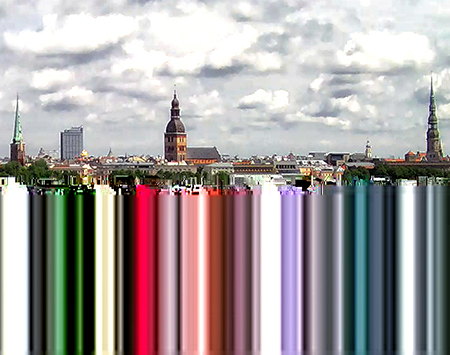 error 33
error 33
Anyway, in the pictures of my Errors series, the data packages have been confused and rearranged in a new order. Pictures like these are singular, they cannot be repeated. With Flusser in mind, we may add that they are more concrete than the images we have learned to consider correct, and that they are more truthful because, just like in Flusser’s thinking black and white photographs are in comparison to their colour counterparts, they exemplify their theoretical background or provenance.
It seems that these erroneous images are at one end of the scale which, at the other end, has the spiders and birds. We encounter the insects caught on the images at the end of empirical photographic truth, and we encounter abstraction at the end of theoretical photographic truth.
In my encyclopedia, which I understand as a kind of atlas and sketchbook to develop other series, all these images find their place.
WB and MD: Actually, we have been wondering about the importance of structure and categorisation in the Encyclopedia of Kurt Caviezel all the time. Some of the categories are more conceptual than others. Sometimes humour and irony seem to be the reason for grouping or its result, but sometimes not.
Can you tell us more about your reasons for choosing particular topics and for using an A to Z form: how important are the titles and individual groupings and series for your work? Do you conceive them before selecting your images, or do you feel the need to categorise your pictures after the fact? And what does the encyclopedic aspect imply for the author and, maybe, for the subject of the book: are you a photographer turned editor and archivist?
KC: Netcams register everything that is the case. Much of it enters my archive. I ruminated over extracting an encyclopedia from this archive for a long time. Once you make the decision, you have to define a structure. A distanced, cool gaze is crucial here. It seemed appropriate to use an A to Z order as a framework, a self-imposed constraint to alphabetic linearity that suggests objectivity.
The individual series’ titles also suggest objectivity. They ought to refer to a main subject in a matter-of-fact way. The rigid grid of the images and the standardized font are also due to the objective mode.
All these parameters allow the viewer to choose his or her own emphases. In terms of content, the series differ a lot from each other. Some have a strong narrative or conceptual bias; others are enumerative, analytical, in a reportage style.
My encyclopedia shows netcam images in a sketchy primordial order, as it were, like they exist in my archive. Some of the series quit the limitations of the book when they are further developed for exhibitions.
Under this new condition, each subject demands an individual display style: smaller or bigger prints, diverse supports and frames, arrangements – sometimes as wallpapers, sometimes in the form of installation art.
I also sometimes use videos based on my individual pictures. With these changing contexts in mind, we may say that my images change their aggregation state no less than the apparatus does: the images can be said to be solid prints or fluid videos or gaseous in the world-wide web or, as they are in my encyclopedia, solid prints.
But the grid hints at their versatility, and I like to think of my encyclopedia as part of an innovative overall project that visualizes the potential of netcam imagery. With this in mind, I should probably claim that I am a photographer, author, curator, editor and archivist.
WB and MD: You mentioned the importance of a distanced gaze, and we feel that in combination with your categorization system, you have a predilection for an imagery that is rather polite and restrained.
This is particularly interesting if we consider the general tendency to associate netcams with unsolicited surveillance, self-exposure, pornography. Actually, one of the series in your encyclopedia is entitled ‘Voyeurism’. Many viewers will feel that the whole book could be considered, although without a moral bias, an instance of cool voyeurism. Do you think that this term could capture your entire work? Does it make sense to reconsider Red Light as part of a continuous artistic agenda in this context?
KC: Netcams are cameras and they serve to take pictures of what is before their lens. While this is a commonplace description of each and every camera, it is often neglected when it comes to picture-making via the web.
When I look through a surveillance camera, I do not necessarily have to be surveilling something or someone. I am interested in the pictorial aspects.
I try to avoid obeying the intentions of the operators. Strangely, many people adopt the intentional gaze of the operators and see what they are supposed to see: the ‘evil’ delivered by surveillance cameras; beautiful landscapes delivered by mountain-top cams. In order to take a closer look at the real, I have to take a distanced approach to the operator’s parameters.
In the same vein, I try to respond to the voyeuristic attributions; I am frequently confronted with them, but I am less than happy with them, and my system of classifications helps stress the distanced gaze.
Take the standardized perspective in Red Light. My perspective into the car and the evening light shining down was always such that the people in the car cannot be identified. Most faces are only lit up to the area of their noses while the upper part is in the shadow or completely hidden from sight. They may be able to identify themselves, but others won't be able to recognize them. This is important from a juridical point of view. Sequencing the individual images into series of gestures, actions, objects, and car interiors, also helped to avoid the implications of voyeurism.
In my Encyclopedia, the series entitled Voyeurism offers a tongue-in-cheek version of voyeuristic imagery. It does offer insights into bikinis, that is, instances of a conventional, dull, vulgar voyeurism. Seen as part of a sequence, however, the individual pictures assume a different meaning. All these pictures are so blunt and grotesque that they form a wonderful ensemble, with humour coming in. I, for one, always start to laugh when I contemplate these pages.
WB and MD: After completing Red Light, you have been pursuing your netcam project for more than 15 years, and you made a point of using structural limitations as a working method.
However, we wonder if the use of fixed cameras ever might become too much of a constraint: can you imagine a point where abandoning the project makes sense? Or does it only make sense while it is endlessly and ceaselessly pursued, like Garry Winogrand’s wonderfully obsessive photography: since he left a massive backlog of unprocessed images behind, one could say his life stopped before his photography.
KC: I believe that the cameras’ limitation to just one point of view is actually an advantage. It encourages looking closely, and the creation of series that would not be possible under different conditions.
I also cannot see a lack of scenic variety. There is a daily influx of thousands of new options. As a matter of fact, my work demands strict continuity, and I cannot see an end to it in the near future.
With every first downloaded picture from a newly-discovered netcam, a new sequence sees the day. The world can indeed be photographed – on a scale with no upper limit.

.jpg)
